EGIDA
Public Association for Animal Protection (Belarus)
 When you are sick, when you have pain somewhere, you take a pill or other kind of medicine and the pain leaves you. But does the pain leave the dogs that this medicine was tested on? Did you ever think of this? I will answer for all of us: "No, we didn't!"
When you are sick, when you have pain somewhere, you take a pill or other kind of medicine and the pain leaves you. But does the pain leave the dogs that this medicine was tested on? Did you ever think of this? I will answer for all of us: "No, we didn't!" Why? In Belarus there a lof of reasons. The first and the main reason is that since quite a long time an indifferent, and often cruel, attitude towards animas was formed in this country. This was caused by the absence of the legislation protecting the animals from the cruel treatment.
In all developed countries there are laws that regulate the treatment of animals by persons or companies owning them. In particular, the rules of treatment of laboratory animals used in scientific research, studies and medial production are often very carefully determined.
In all countries around Belarus, even in Ukraine, the use of animals is permitted only if it is impossible to use other alternative methods. In all these countries the animals are protected by the law.
And in Belarus?
And in Belarus there are vivariums full of domestic, affectionate, licking your hands dogs... How come?!
There are candidates for degrees that need to defend their theses and that's why they need "ten-twenty-thirty" dogs.
Untill now nobody has asked Belarussian physicians why in the 21st century they need SO MANY DOGS in their experiments. We have asked. And we received an answer from BelAPS (Belarussian Academy of Post-Universal Studies) dated from June 18, 2009, signed by the rector - Prof. Y. Demidtchik. It states that:
| "In april-may 2009 BelAPS has bought 18 dogs from "Fauna Goroda"... All researches using dogs where held within the state scientific programmes..." |
It is time to stop signing hymns of the glory of the "state research programmes" within which people torture dogs. The time has come to ask if there is a separate "state programme" for each dog or one for all of them. And where is in Belarus an authority that gives permissions to held scientific research on animals? Who determines the necessity of each thesis and the quantity of dogs that are operated for that thesis?
In Belarus everything is very simple. The cadidate for degree makes a rough calculation of how many dogs he will need for his work. And he takes as many as he wants, because the Rules for the realisation of research using laboratory animals are developed by the same body that is using them for the experiments.
An interesting fact: in 2008 there were no dogs in Minsk vivariums. Only rabbits, mice, rats...
In the beginning of 2009 they have started to buy dogs in "Fauna Goroda" (Minsk). This happened at the same time that a new director came to "Fauna Goroda" and at the same time every employee connected to the animal protection movement was fired.
Two organisations have started to actively buy dogs in 2009: BelAPS and the vivarium of the Belarussian State Medical University. Though, some years ago Prof. Morozkina from this same university stated in one of her articles:
| "Before, the cruel experiments on animals could at least be explained by the necessity of gathering the fundamental knowledge in medicine. Nowadays the sufferings of the animals are senseless. A moral duty of a scientist is to constantly look for ways of getting the similar results without usage of animals." |
But for Belarussain scientists it is very difficult to look some other ways (there is even no need to look for them as they are already widely known in the scientific world). It is much more easier to buy dogs in "Fauna Goroda" and cut them for their theses and use the "state programmes" as a cover .
And let us ask you one more question, that nobody is asking: how are held the laboratory dogs in vivariums and where do they go after the exprements are done?
In the same document from the BelAPS (18.09.2009): "The animals are held in permanent conditions of the vivarium with a full food ration."
On the photos below you can see yourself those conditions.
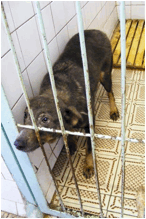

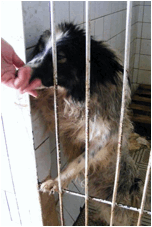
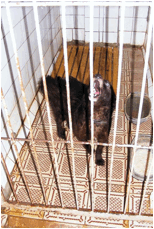
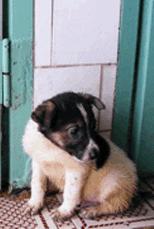
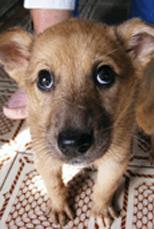
That is the vivarium of the Belarussian State Medical University. In the BelAPS the vivarium conditions are even worse. There, the dogs are divided by bars in small boxes. They are held on chains and are sitting on wooden perches. In rows... Side by side... We will not tell you how they recover from the operations, what pains they go though, how they are anesthetized, etc...
We will touch a more prosaic topic: how much time they are held in those "permanent conditions" and who takes care of them and how.
They spend there as much time as it is needed for the "state programme"! That can be six months or one year (if they survive that long...).
Let us imagine that the sufferings of those dogs are really necessary for the well-being of the humanity and that their sufferings are well-founded. How do people help these dogs, that are sacrificed in the name of the "state programme", to overcome those sufferings? What do they do for them? Who takes care of them after the operations? Are they taken for a walk during their stay in vivariums? Or during all these long months standing those terrible pains after operations they go as well through the physical sufferings, waiting for the death without walking and wihtout a king word?
Today, after visiting the vivariums of Minsk, after seeing the dogs and after talking to the officials regulating the processes fo the laboratory research on animals, we make an official statement:
| The dogs, that are used nowadays by Belarussian physicians for their theses are held in vivariums in the conditions that get under the article "the cruel treatment of animals". |
As we have mentioned before, only kind dogs get to vivariums. They are all home dogs. Most of them are the lost ones. On the pictures below you can see Jacque. He is one of those lost dogs. His picture was published on the EGUIDA's website the day when he was caught by the catchers of the "Fauna Goroda". Some days after the director of the "Fauna Goroda" sold Jacque and some other dogs for the experiments.
Jacque got to Minsk from Molodetchno (a town not far from Minsk). July 2009, his gardians brought him to Minsk to visit a good veterinarian. In Minsk Jacque got out of the car and... got lost. Their gardians have tried their best to find him. They saw the picture on the website, called the volonteers and finally found Jacque in the vivarium of the Belarussian State Medical University.
On the pictures below you can see how Jacque is taken back from the vivariums by his owners. The last picture is taken on the Minsk railway station. jasque is going home!

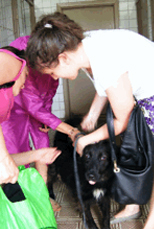
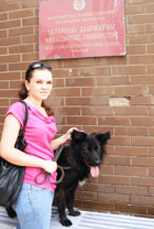
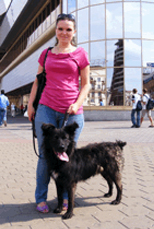
Instead of Jacque, on the next day the vivarium has bought another dog from the "Fauna Goroda". Also a kind one. Also a lost one. It did not have chance like Jacque. It is already dead. It didn't stand the pain during the experiments on the pancreatitis. During these experiments the gall is driven under pressure into gall ducts. The pain is so that the dogs die of a broken heart......
На сайте: 23
Гостей сайта: 21
Пользователей: 2

Your comment